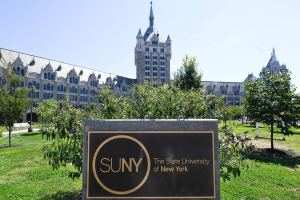History
The SUNY Board of Trustees approved the creation of the University Faculty Senate on October 8, 1953. Article VII of the SUNY Policies of the Board of Trustees states “the Senate shall be the official agency through which the University Faculty engages in the governance of the University. The Senate shall be concerned with effective educational policies and other professional matters within the University.”
The UFS membership consists of the Chancellor of the University, two University representatives having University-wide responsibilities and representatives from each State-operated unit and contract college. This is a total of 33 SUNY colleges. This makes the University Faculty Senate one of the largest faculty governance organizations in the country!
 The University Faculty Senate serves as a resource on governance for the University. It serves as a deliberative body on educational policies for the SUNY System. In this capacity it issues publications such as handbooks, directories and reports on matters such as budget, program revision and presidential searches.
The University Faculty Senate serves as a resource on governance for the University. It serves as a deliberative body on educational policies for the SUNY System. In this capacity it issues publications such as handbooks, directories and reports on matters such as budget, program revision and presidential searches.
The University Faculty Senate held its first meeting in Albany on December 15, 1953, five years after SUNY was founded. The idea for a university-wide faculty governance organization was raised in 1950 at the State Teachers College Faculties Association and a committee chaired by Professor J. Murdock Dawley from the Fredonia campus was given the task of exploring the possibility of forming such an organization. The following year, on December 7, 1951, at the Paris Hotel in New York City, representatives from 29 SUNY units formed a committee to write a constitution. On March 19, 1953, the document was completed and submitted to the SUNY campuses for ratification. After three-quarters of the campuses ratified the constitution, the SUNY Board of Trustees approved the creation of the University Faculty Senate on October 8, 1953, and shortly thereafter, the Senate met. The original language called for the President of SUNY (now the Chancellor) to be the presiding officer of the Senate, with the body electing its own Vice Chair and Secretary. At this historic first meeting, the President of SUNY, William Carlson, presided; J. Murdock Dawley as elected Vice Chair, and Loren Petty (Cornell Agriculture) was elected Secretary.
Each campus had equal representation and one vote in the Senate’s formative stage, but in short order a proportional system of representation was adopted. A committee structure was utilized, with the number of committees changing over the years. Currently there are six standing committees.
The Faculty senate serves as a resources on governance for the University. It serves as a deliberative body on educational policies for the SUNY system. In this capacity it issues publications including proceedings, directories, and handbooks on matters such as budget, program revision, and presidential searches. It serves as a repository for documents and for tapes of Plenary Sessions.